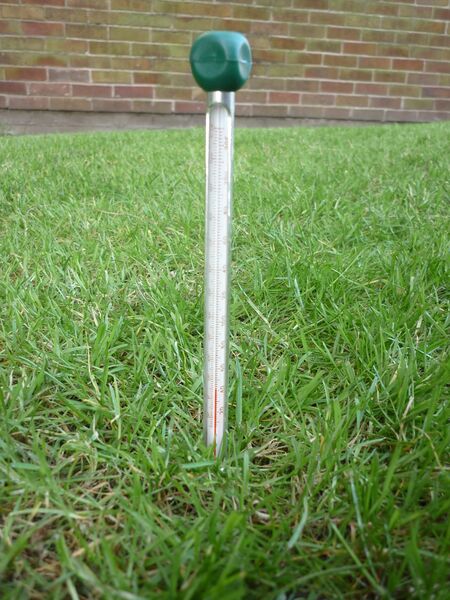Keeping your lawn well-maintained reflects on you as a homeowner, so it’s important that it looks good. You may, however, need to occasionally repair bare spots and reseed sections of your yard to keep it looking fresh. The secret to success when seeding your lawn is timing, and we’re going over the best time to plant grass on your lawn.
Related Content
How to Revive Your Lawn After Winter
How to Prepare Your Lawn for Spring
When Is the Best Time to Plant Grass Seed?
The best time to plant grass depends on your climate region. Since there are so many different grass species that all thrive in certain areas, you should plant grass that’s suited to your growing region to ensure success.
As a rule of thumb, you can separate grass species into two categories: Warm-season and cool-season. Warm-season grasses perform the best when planted in the spring, while cool-season grasses turn out best when planted in the fall.
Some of the most popular cool-season grasses include Kentucky bluegrass, perennial ryegrass, and fescue. Meanwhile, Bermuda, zoysia, and centipede grasses do better in warmer areas. If you’re in a transitional area between cool and warm-season regions, you should plant both varieties.
Why Timing Matters When Planting Grass Seed
When you plant grass during its peak growing conditions, the germination rate will be higher and there is also less of a chance that it will develop a disease. It also ensures that it can be established before harsh weather conditions arrive.
Knowing when the best time to plant grass seed can avoid discouragement while also saving you time and money. Each grass type has its own optimal growth cycle, which will lead to faster growth when you pair it with the conditions of your climate region.
When to Plant Cool-Season Grasses
Cool-season grass seeds germinate best when the temperatures of your soil range from about 50°F-60°F (10°C-15°C). During the fall, the soil is still warm from the summer sun, but chilly autumn nights promote germination for these types of grasses.
In northern regions, planting cool-season grasses in the fall gives your lawn three whole seasons to become established before becoming dormant in the summer heat. Cool-season grass also needs more moisture than warm-season grass. It grows best in temperatures between 55°F and 90°F (13°C to 32°C)
You could also plant cool-season grass in the springtime. Doing this prevents your lawn from becoming established before hot summer weather threatens it. Be sure to keep it well-watered throughout the summer months.
The farther north you live, the earlier you can plant cool-weather grass in the fall. In many northern parts of the U.S., you can start planting once nights start to cool in August.
Use a Soil Thermometer to Determine When to Plant Your Grass Seed

A soil thermometer is a foolproof way to tell when soil reaches the ideal temperature for planting grass seed. To use one, insert the thermometer’s probe at least four inches into the soil. Wait around five minutes before reading the temperature. When temperatures are consistently 50°F to 60°F, you can start planting your cool-season grass seed.
When to Plant Warm-Season Grasses
In warmer regions, the spring rains and warm soil temperatures create the perfect environment for grass germination. Warm-season grasses enter peak growth cycles in the late spring and into the summer when soil temperatures are above 65°F (18°C).
Warm-season grass thrives when planted in the spring due to having several months of warm weather ahead. It needs at least 90 days to develop strong roots before the cold weather sets in, however.
The farther south you live, the earlier you can plant warm-season grass in the spring. If you live in Florida or southern California, you can safely plant warm-season grasses starting in April. Be sure to use a soil thermometer to determine when the soil reaches 65°F to 70°F, which is the best soil temperature for warm-season grass germination.
Other Factors That Influence Seeding Times
To achieve the best results possible, pay attention to other factors that can influence grass seed germination and lawn health.
Location in the Yard
Yards have microclimates that affect plants and grass in many ways. The amount of shade and direct sunlight an area gets can affect everything from seeding times to watering frequency for your newly planted lawn.
Different parts of your yard can also have different soil types. Soil health plays a critical role in your grass seeds germinating, as well as the overall health of your lawn.
Upcoming Weather
Be sure to think ahead when planting grass seed. Warm-season grass planted too late in the season won’t be able to establish before winter. By the same token, cool-season grasses planted in the spring won’t have enough time to develop roots before the weather turns hot.
Additionally, if there’s a big storm or heavy rain in the forecast, you should wait until after it rains, since rain can wash away newly spread seeds. Plus, you want to be in control of soil moisture levels as much as possible.
The Last Time You Applied Herbicides
You should wait at least a month after applying herbicides before planting grass seed. Even though weed and feed products don’t target grass, they can still weaken tiny grass seedlings.
Always track herbicide applications to ensure you’re not over-applying them and to help gauge their effectiveness. After planting grass seeds, wait three to four months before applying herbicides on your lawn.
Other Activities That May Affect the Seeding of Grass
Since there is usually a lot of activity on lawns, it can be hard to schedule the best time to plant grass seeds.
If you have children, the best time to seed your lawn in cool regions is when they return to school after the summer. In warm climate regions, try to plant grass seeds before the kids go on summer break.
If kids and pets are home, plant one side of your lawn at a time so they have somewhere to play. A temporary fence or barrier can help to keep everyone off of that area of your newly planted grass. It’s also best not to plant grass seed right before you go on vacation, since it needs intensive care for the first few weeks.
How to Prepare Your Lawn to Plant Grass
Properly prepared soil can create a strong foundation for your lawn to thrive. You should aerate, rake, and level your soil to ensure proper absorption of water, nutrients, and fertilizer.

If your soil is heavily compacted, it may be a good idea to till it to create a seedbed.
Before planting grass, level the ground with your rake. Water can pool in any dips or footprints, taking new seeds with it, so make sure it’s as level as possible.
How Long Does Grass Seed Take to Grow?
It’s important to understand how long grass takes to germinate and grow. Grass seed germination time can vary based on several factors, including soil temps, sunlight, moisture, and seed type.
Some grasses sprout in as little as five days in ideal conditions, but it can sometimes take up to 30 days to see any germination.
How to Care for Newly Planted Grass Seed
The most critical factor for newly planted lawns is water. For healthy new grass, keep the top half-inch of soil moist until grass seedlings are at least an inch tall. Water your lawn lightly 1-3 times every day, but make sure not to overwater it, which can wash away newly planted seeds.
Wait until your lawn grows to at least three inches tall before you start your mowing schedule. Also, set the blades high to avoid cutting your grass too short.
After four to six weeks, you can fertilize your lawn with a good quality turf fertilizer, however you should wait three to four months before applying fertilizer.
FAQs About When to Plant Grass Seed
Is March too early to plant grass seed?
In nearly every part of the U.S., March is too early to plant grass. The best time to plant grass is when the soil temps reach ideal levels for your grass seed type. In the spring, use a soil thermometer to determine when the temperature is consistently above 65°F to 70°F.
Can you plant grass seed in the winter?
Planting cool-season grass seed in the winter is known as dormant seeding, and there are risks to it. For starters, the grass seed can wash away or fail to germinate at all. However, if it does sprout, it gives your grass a head start in the spring once soil temperatures warm back up.
Can you plant grass seed in the fall to get it to grow in the spring?
Cool-season grass seeds perform best when planted in the fall. Unlike warm-season grass, these types prefer cool temperatures and moist conditions. They will continue growing throughout the spring when warmer temperatures return.
For warm-season grass, you should avoid planting in the fall, as the seed may rot. Even if it does germinate, the cold weather will prevent it from thriving.
Warm-season grass naturally turns brown during the winter, going dormant in cool temperatures. For this reason, many people overseed their lawns with cool-season grass seed during the fall to keep their yards looking green. If you plan to do this, you should start about 45 days before the first frost to give your new seeds time to germinate.



